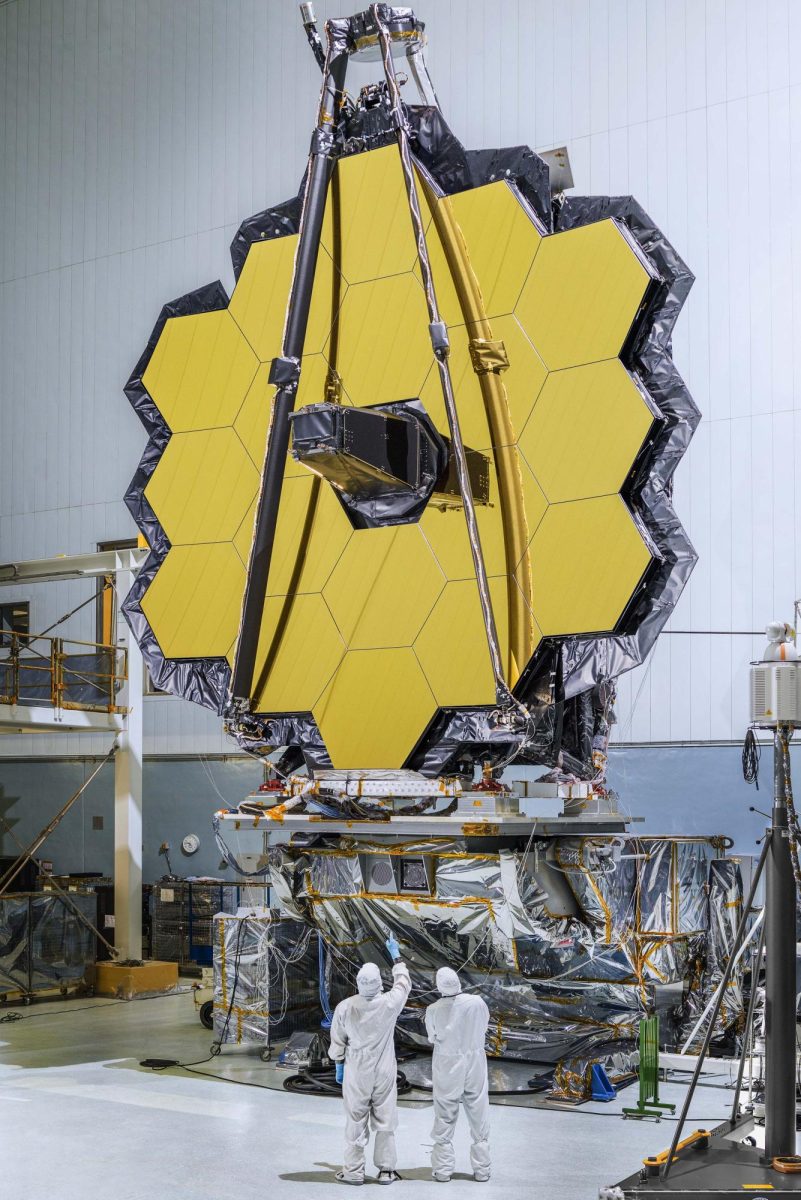Previously published Feb 16. 2022
At 7:20 a.m. EST on Christmas Day in 2021, the astronomy community and humanity as a whole received a gift years in the making – the launch of the James Webb Space Telescope. The James Webb Space Telescope is a 10 billion dollar,13,584 lb, 66.26 ft x 46.46 ft space telescope developed in a collaborative effort between NASA, the European Space Agency, and the Canadian Space Agency. Launched on an Ariane 5 rocket from Guiana Space Center in Kourou, French Guinea, the James Webb Space Technology marks a monumental achievement in space observational technology and instrumentation as the main successor of the Hubble Space Telescope launched in 1990.
So what makes the James Webb Space Telescope so impressive, and what functions is it prepared to perform? The James Webb Space telescope is outfitted with a series of tesselated 18 gold coated hexagon-shaped smaller mirrors that compose its primary mirror, or its main reflective surface. This mirror permits the telescope to view infrared light emitted by luminous objects over 13.5 billion years ago that have been redshifted or stretched by the expansion of the universe since that time. Thus, Webb will be able to study planets both within and around our solar system, making observations about the chemical compositions of these bodies through transmission spectroscopy. To maintain the telescope’s ability to make these observations, Webb must be kept below -369.7 degrees Fahrenheit, thus necessitating a multi-layer sunshield that can redirect light and heat from other bodies. Webb additionally hosts a variety of instrumentations and sensing equipment to perform functions like infrared imaging and spectroscopy, all of which is housed within the Integrated Science Instrument Module, or ISIM. The last main component of Webb is the spacecraft bus, which serves to support and maintain the entirety of the telescope and its orbit through computational instruments, solar panels, and propulsion systems.
Given this extensive nature and scope of its construction, the James Webb Space Telescope was plagued by a series of setbacks and delays since its inception. Northrop Grumman was contracted to build the spacecraft and sunshield itself, while Ball Aerospace & Technologies was responsible for the mirror and ISIM. Planning and development of Webb began all the way back in the 1990s as scientists sought to address shortcomings brought about by the Hubble Space Telescope. Webb was originally planned to launch in 2007, but following both technical and funding issues, the project was repeatedly delayed; a 2010 review rescheduled the launch to as late as 2018, and in 2018, another review identified hundreds of technical single-point failures, further pushing back the launch to 2021, where it was then pushed from March to October to December thanks to complications introduced in part by the COVID-19 pandemic. The overall cost of the telescope ballooned from a projected 0.5 billion dollars in 2007 to 9.7 billion dollars in 2021. Despite these failures, the team persisted; integration of the telescope was completed in 2019, and the launch date was finally set to December 25th, 2021.
After launching from New Guinea upon the Ariane 5 rocket, the James Webb Space Telescope undergoes a multistage deployment process as it reaches its final destination and begins to orbit around the sun. Firstly, on the day of launch, the solar array upon the telescope unfolded into a fixed position. Next, on January 4th 2022, the telescope successfully unfolded and tensioned the sunshield. Finally, the mirror was deployed and assembled into place as well – sets of folded segments of the main mirror on both sides of the telescope were latched into place on January 8th, 2022 at 1:17 p.m. EST. With Webb now fully deployed, it is well on its journey to its final position where it can begin to orbit the sun, the Earth-sun Lagrange Point 2. A Lagrange Point is a position in which the gravitational forces of two bodies, like the Earth and the Sun, reach an equilibrium point of stability, allowing the body in that location to easily maintain its position. This spot is ideal for Webb, providing it with a clear view into space while gaining solar power and being able to communicate with Earth. L2 is 930,000 miles away from the Earth, though Webb is already approximately 85% of the way as of January 13th, 2022. As Webb continues on its journey, each mirror segment is adjusted and aligned as part of a series of calibrations and instrument preparation that will extend far beyond Webb’s arrival at L2.
The James Webb Space Telescope has four major goals as stated by NASA: to study the first light of the universe, galaxy assembly in the early universe, the birth of planetary systems and stars, and planets. Webb will be able to produce high-quality images of space phenomena beginning about 6 months after launch, where it will embark upon a 5-year mission, and has a predicted operation lifespan of about 10 years. Given the incredible engineering and technology that has gone into the development of the James Webb Space Telescope as well as its immense capabilities, it’s difficult not to be excited about what discoveries Webb has in store for the future.

















![Teacher [Milk] Tea: Part 2](https://bisvquill.com/wp-content/uploads/2024/03/Screen-Shot-2024-03-19-at-9.28.48-PM.png)


































